by Giorgio
Busetto
|
click on images to enlarge
SILVER KANTHAROS FROM POMPEII
A "Five Ws" Investigation (WHY, WHO, WHAT, WHEN, WHERE)
Some time ago Ampelio Vimercati wrote
"I send the photos of two silver "kantharos" I bought about
twenty years ago.
They are 14 cm. high, diameter at the top 10.5 cm. (15.5 cm. at
handles) and 5 cm. at the base and they weigh 910 and 978 grams
respectively.
The Kantharos have no hallmark or maker's mark to indicate their
origin and bear only a later fineness mark "800".
Anyway we are in the presence of beautiful artifacts, crafted by a
highly skilled silversmith."
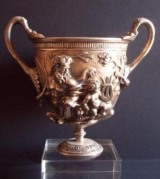 |
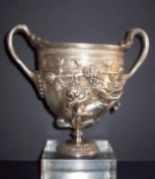 |
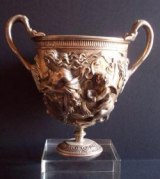 |
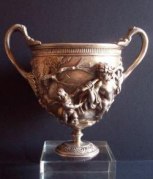 |
kantharos No 1: front
|
kantharos No 1: back
|
kantharos No 2: front
|
kantharos No 2: back
|
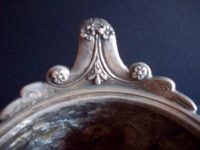 |
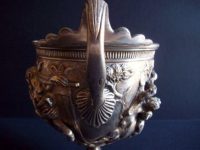 |
silver kantharos: detail
|
silver kantharos: detail
|
These images were an excellent base for a research of
information about these objects and the original pieces that
inspired their manufacture: a classical example of "Five Ws" (WHY,
WHO, WHAT, WHEN, WHERE) investigation
(note 1).
The WHY
These cups are in full evidence the reproduction of ancient
Roman vases made since the mid of the 19th century as a token of
the "Grand Tour"(note 2)
in Italy and later for decorative purposes. An example of a
slightly different drinking cup ( a "Skyphos/Scyphus") made in
Rome before 1870 is illustrated in Fred Sinfield/Giorgio Busetto
article # 40 on ASCAS website
(note 3).
the WHO
Isn't possible to identify the maker. Also the country of origin
remains uncertain but it's highly probable that these cups were
manufactured in Italy in the period 1870/1935 when the official
marking was optional and only the fineness mark (800) was
applied to silver pieces.
the WHAT
What is the Kantharos (Greek) or Cantharus (Latin)?
It is a bronze or silver cup with tapering body or in the shape
of a hemisphere, raised up on a high foot, with two slender
vertical handles, sometimes surmounting the rim. The body is
often decorated with floral motifs or figural scenes. Examples
of silver kantharos decorated with Tritons and Nereids (from
Pompeii), grapevines (from Alesia), olive shoots and rich
embossing (Pompeii, House of Menandro) and other decorative
elements survive and are exhibited in various museums.
the WHEN
At the end of March of 1835 the Minister of Internal Affairs of
the Kingdom of Two Sicilies (Naples) ordered to resume the
excavation of the so called "strada della Fortuna" in Pompeii.
the WHERE
During the excavation in the so called "casa dei vasi d'argento
(House of Silver Vases)" was discovered a treasure of 14 vases
comprising two silver Kantharos embossed with centaurs and
cherubs. These vases, now at the Museo Archeologico Nazionale of
Naples, are the original silverworks that inspired the unknown
modern silversmith.
By the comparison of the Pompeian kantharos with the
corresponding recent reproductions we notice that the ancient
pieces are slightly smaller (-12%) while their weight is about
50% less. We notice also that the modern pieces were closely
inspired by the ancient ones, but that much differency characterize the
scenes embossed on their surface.
And lastly, the outstanding quality of the Pompeian artifacts and the exceptional
craftsmanship of their makers is clearly evident.
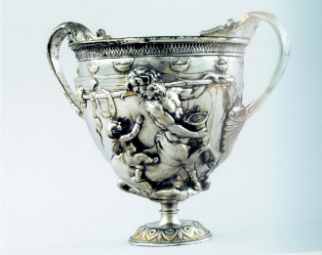 |
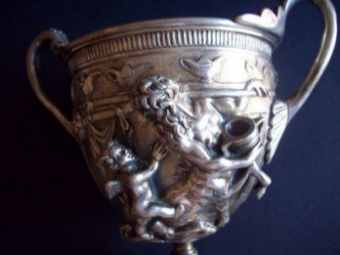 |
silver Kantharos - I century A.D.
Centaur (male) with "krater" and cherub
high 12.5 cm - diam. 12.2 cm. - weight 648 gr.
|
silver kantharos - modern copy
detail with Centaur (male) with "krater" and cherub
high 14 cm. - diam. 10.5 - weight 978
|
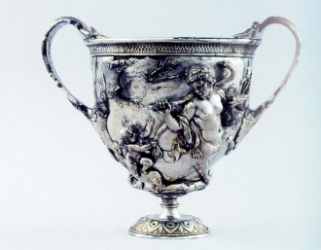 |
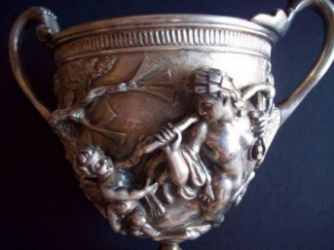 |
silver Kantharos - I century A.D.
Centaur (female) with cherub
high 12.5 cm - diam. 12.2 cm. - weight 648 gr.
|
silver kantharos - modern copy
detail with Centaur (female) with cherub
high 14 cm. - diam. 10.5 - weight 978
|
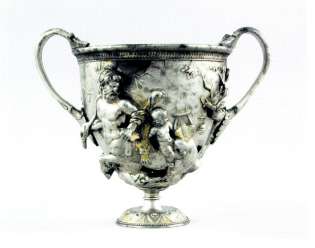 |
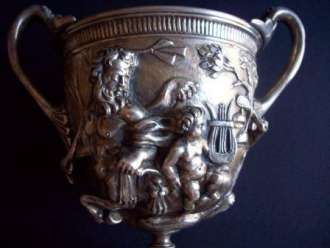 |
silver Kantharos - I century A.D.
Centaur (male) and a cherub holding a flute and a
lyre respectively
high 12.5 cm - diam. 12.2 cm. - weight 631 gr.
|
silver kantharos - modern copy
detail with Centaur (male) and cherub with flute and
lyre
high 14 cm. - diam. 10.5 - weight 910
|
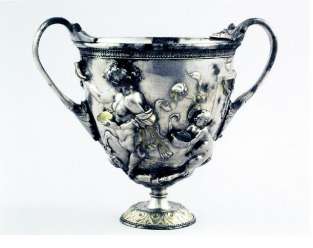 |
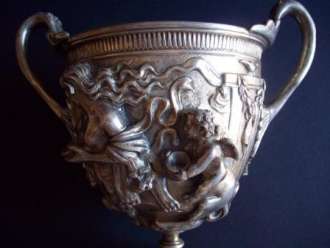 |
silver Kantharos - I century A.D.
Centaur (female) holding a rython and a phiale (ritual
vases) and a cherub holding a cup
high 12.5 cm - diam. 12.2 cm. - weight 631 gr.
|
silver kantharos - modern copy
detail with Centaur (female) holding ritual vases
and a cherub holding a cup
high 14 cm. - diam. 10.5 - weight 910
|
|
Giorgio Busetto
- 2008 -
http://www.silvercollection.it
My thanks to Ampelio Vimercati who supplied the photos of his
kantharos subjects matter of this article
|
|
 ASSOCIATION OF SMALL COLLECTORS OF ANTIQUE SILVER
ASSOCIATION OF SMALL COLLECTORS OF ANTIQUE SILVER ASSOCIATION OF SMALL COLLECTORS OF ANTIQUE SILVER
ASSOCIATION OF SMALL COLLECTORS OF ANTIQUE SILVER